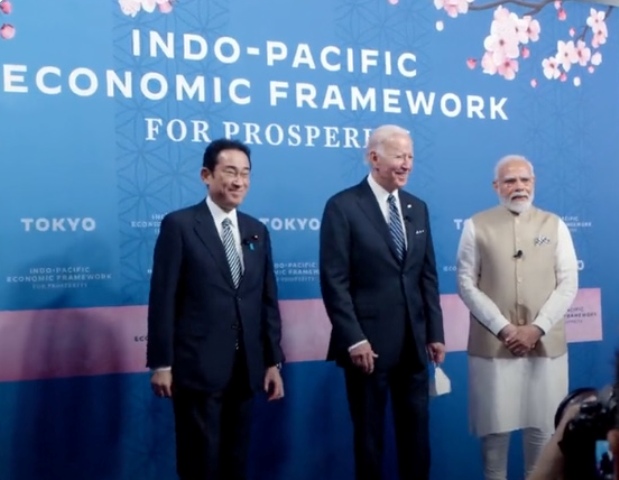 May 23, 2022: Japan’s Prime Minister Fumio Kishida, President Joe Biden and Prime Minister Narendra Modi at the launch of the Indo-Pacific Economic Framework for Prosperity in Tokyo. Analysts say the Framework is aimed at countering China’s growing influence in the region. [Picture source: POTUS Office video]
May 23, 2022: Japan’s Prime Minister Fumio Kishida, President Joe Biden and Prime Minister Narendra Modi at the launch of the Indo-Pacific Economic Framework for Prosperity in Tokyo. Analysts say the Framework is aimed at countering China’s growing influence in the region. [Picture source: POTUS Office video]
[These two excerpts are from an article in The Round Table: The Commonwealth Journal of International Affairs.]
Introduction
India’s relations with the US have come a long way from the Cold War period, when New Delhi was considered as a Soviet follower. While India was apprehensive of American motives in the region, Washington remained committed to Islamabad. As one Indian scholar points out that ‘even as China continued to change the strategic environment around India to New Delhi’s disadvantage, our [Indian] favourite pastime was to talk about the various versions of non-alignment. We pretended that if we remained equidistant between Beijing and Washington, we would be able to keep China in good humour. In summit after summit with our Chinese “friends” we railed against American imperialism and unipolarity’ (Pant, 2021). Much has changed since because the regional geopolitics has been turned on its head. President Bill Clinton’s historic India visit in March 2000 signified a changing US South Asia strategy with a warm New Delhi-Washington rapprochement (Hathaway, 2002). The Bush and the Obama administrations continued to transform the Indo-US relationship. It would be instructive to quote William J. Burns, the US diplomat charged with pushing through the US-India civil-nuclear deal in 2008, who explains the investment America made for improving ties with India. Burns writes that ‘I have sheepish memories of waking senior European officials in the middle of the night to obtain an exception for India from the Nuclear Suppliers Group. I did not belabour the technical arguments, nor did I really try to do much convincing. This was about power, and we were exercising it – hardly endearing ourselves to groggy partners, but impressing our Indian counterparts with the strength of America’s commitment to get this done’ (Burns, 2020). Indian and American interests have never been more aligned as both are cooperating on a wide range of issues, including China’s growing power, counterterrorism, nuclear non-proliferation, defence cooperation, peacekeeping, climate change, cyber security, health, agriculture, education, technology and space.
It goes without saying that India’s relation with the US is one of the most consequential relationships of the current century, and both have developed a robust mechanism of regular high-level summits, military exercises, arms trade, and people-to-people contacts. Like his predecessor Donald Trump, the US President Joe Biden seems to have identified India’s potential as a counterbalance to China. The growing convergence has opened up new opportunities for strategic collaboration between the two sides. The aim of this article is to provide visibility to the Biden administration’s India policy as its contours will define the future international order as well as the balance of power in the Indo-Pacific region.
We are living in an age where military dominance has to be accompanied by economic strength. The Biden administration’s primary focus seems to be to weaken China economically. In order to undermine China’s rising military capabilities, the US has imposed multiple sanctions on Chinese companies, accusing them of indulging in malpractices and stealing technology. By denying them any access, Washington expects to retard Beijing’s technological capabilities. On the other hand, China has also taken reciprocal steps by banning several American companies. Thus, the global economic architecture that was built over the last few decades is under greater turbulence. How the global markets will adjust to these changes is of serious concern to India.
The first major Sino-American meeting under the Biden administration, at Anchorage in Alaska on 18–19 March 2021, witnessed the new foreign policy consensus in Washington. The top diplomats of both countries verbally attacked each other in very blunt language. Secretary of State Anthony Blinken and National Security Advisor Jake Sullivan made it clear how the US saw the Chinese game plan on territorial and technological domains but their Chinese counterparts were equally aggressive. The theatrical exchange was not only undiplomatic but departure from convention (Sirohi, 2021). Blinken openly criticised China for its cruel treatment of the Uyghur community in western China while castigating its authoritarian crackdown in Hong Kong. He also warned against any further cyber attacks on the US emanating from China, and raised questions about China’s economic coercion of Australia. On the other hand, China’s Yang Jiechi, accused the US of hypocrisy and using its supremacy to suppress other countries, while mocking its fragile democratic institutions. It can be reasonably argued that these hostile Chinese responses were aimed more at domestic audiences, and meant to signal that Beijing considers itself equal to Washington. Against this background, there are debates on US–China strategic competition among Indian scholars and policymakers. India’s former foreign secretary pointed out that ‘China will play the geopolitical game by its own rules or, at the very least, insist on negotiating new terms of engagement where its interests must be deferred to’ (Saran, 2021). One cannot rule out the possibility that the US will separate most of the trade relations with China from the two countries’ political equations.
Vinay Kaura is with the Department of International Affairs and Security Studies, Sardar Patel University of Police, Security and Criminal Justice, Jodhpur, India.



